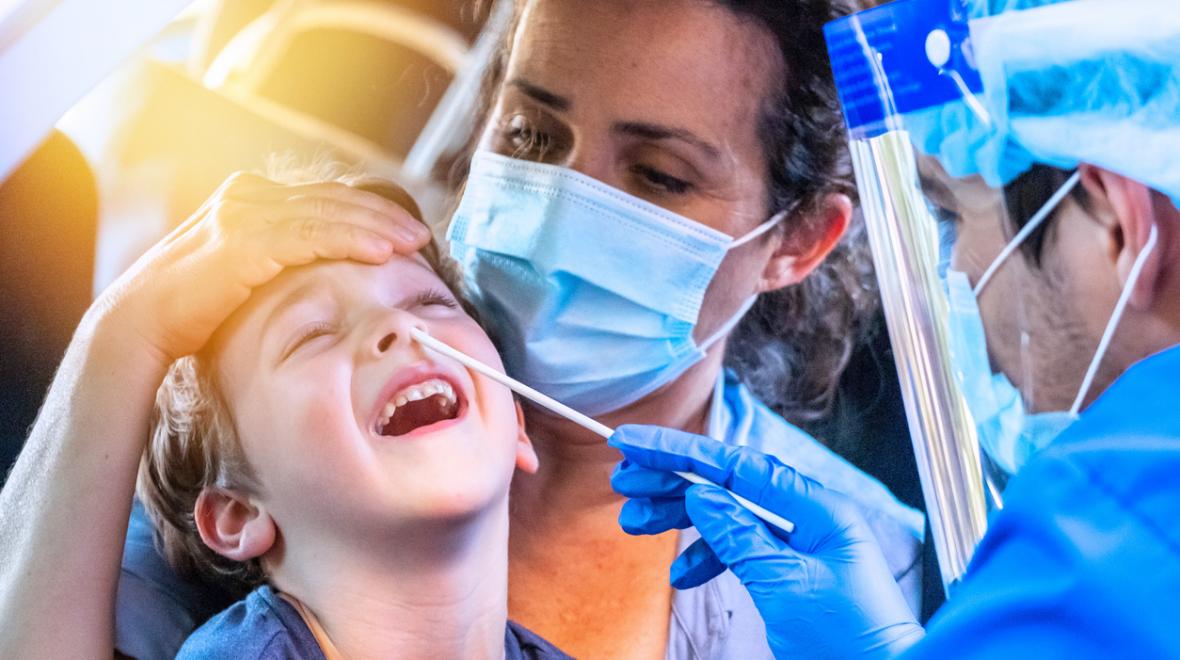
With COVID-19 infection rates skyrocketing and many families hoping to see relatives during the holidays, interest in testing is higher than ever. In fact, testing facilities are overwhelmed by demand and are asking people to stay away. So, when should you get tested?
ParentMap spoke with infectious diseases physician Matthew Kronman, M.D., to learn more about what parents need to know related to COVID-19 testing during the holiday travel season. (For more information on COVID-19 transmission and safety precautions for families, watch this recent webinar with Dr. Kronman.)
Why is everybody getting tested now?
On November 15, Gov. Inslee issued new rules affecting families’ ability to gather over Thanksgiving. Indoor gatherings between households are prohibited unless families either quarantine for 14 days first or quarantine for seven days and test negative for COVID-19 within 48 hours before the gathering. With many families hoping to travel to visit relatives outside of Washington, that has led to a lot of people getting tested before the holiday.
Why wouldn’t you get tested?
Although it’s a good idea to confirm that you are not carrying the virus before your visit — especially since you can be contagious while asymptomatic — the unfortunate fact is that local testing sites don’t have the capacity to test everyone. That means longer lines, potentially delayed results and testing sites having to turn away people who really need a test. It even draws resources away from the ability to test for other infectious diseases.
As of this writing, the infection rate in King County hovered around 200 new cases per 100,000 residents — eight times higher than the target rate for moving between phases in the reopening plan set out last summer. So, unless there is a dramatic drop in infection rates, current rules are likely to be extended through Christmas. Between high infection rates and overwhelmed testing sites, you might want to reconsider whether to travel or gather for holidays in December rather than relying on pre-visit testing.
When should you get tested?
According to Matthew Kronman, M.D., associate professor of Pediatric Infectious Diseases at the University of Washington and Seattle Children’s Hospital, “If you are symptomatic and you have had any exposure to the outside world, meaning you haven’t been quarantined for 14 days, then you should be tested because that helps us identify who has the infection and get infected people quarantined to limit the spread to other people.” You should also get tested if you have been exposed to someone who tested positive for the virus, or if you are referred for testing by your doctor (for example, prior to a medical procedure).
For those without symptoms, the decision to get tested prior to travel or a gathering depends on two factors. First, the availability of testing. When public health officials are discouraging people from relying on testing to meet gathering requirements, asymptomatic families should forego testing — and ideally, forego gatherings as well. The other factor is the test turnaround time.
“The longer the turnaround time is, the more chance you have to potentially get exposed between when you get tested and when you leave to go to the gathering,” says Kronman. Also, if you cannot get test results before the event, the test is useless.
What about different types of tests?
There are three types of tests used to detect the coronavirus. Each uses a different technology and has different utility.
Genetic tests are taken with a nasal swab and use a technology called PCR to test for the presence of the virus’ genetic material (RNA). Genetic tests are the most sensitive option and can detect very low viral loads. “The PCR-based tests are generally the gold standard, the best of the tests that are available,” says Kronman. But they are not always available at the point of care (such as your doctor’s office) and because they usually have to be sent out to a lab for processing, the results may take longer to receive.
Antigen tests are also taken with a nasal swab, but they detect proteins from the outside of the virus rather than genetic material of the virus. Their advantage is that they can detect the virus earlier in an infection than genetic tests, and the results are usually available faster. But antigen tests tend to be less accurate once the infection has developed. They can generate false negatives in people who have been showing symptoms for a few days (meaning the test will show that a sick person does not have COVID-19 when they actually do).
Antibody tests do not test for the presence of the virus. Instead, they measure the presence of antibodies in the blood — the body’s response to infection. This is a blood test that shows whether a person has had the infection, and it is not useful for determining whether you are contagious.
Where do I get tested?
You might be able to get a test from your primary care provider. If not, public testing sites have been set up around the region. King County’s free testing sites and guidelines are listed on a web page where you can also make an appointment (highly recommended). Both drive-through and walk-up tests are available. There is also an at-home, mail-in option. Washington state maintains a list of testing sites in each county.
What about testing children?
Kronman says the guidelines for deciding whether to test children, and the corresponding testing procedure, are the same as those for adults. If your child does need to be tested, it may be helpful to let them watch you get your test first.
“Be honest and explain what’s going to happen,” recommends Kronman. Show them the swab and talk them through the process, including the fact that it will be uncomfortable but shouldn’t hurt. “Talk it through and don’t surprise them with it.”











